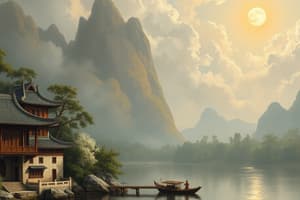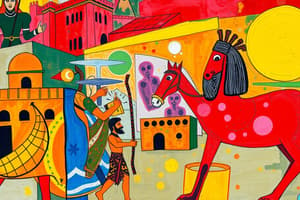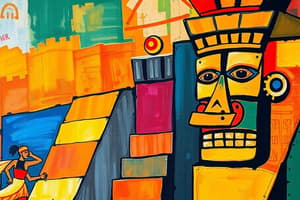Podcast
Questions and Answers
Which of the following civilizations is NOT mentioned in the course contents for the Ancient World?
Which of the following civilizations is NOT mentioned in the course contents for the Ancient World?
- Egyptian
- Greek
- Chinese (correct)
- Harappan
The rise of democracy is discussed in the context of the Medieval World.
The rise of democracy is discussed in the context of the Medieval World.
True (A)
What major trade network is highlighted in the module on India and the World?
What major trade network is highlighted in the module on India and the World?
Indo-Roman trade network
The first major conflict involving European powers during the medieval period is known as the _____ .
The first major conflict involving European powers during the medieval period is known as the _____ .
What is one of the learning outcomes of this course?
What is one of the learning outcomes of this course?
Match the period with its corresponding focus:
Match the period with its corresponding focus:
The course requires students to write three mandatory journals.
The course requires students to write three mandatory journals.
What topic is NOT offered for the FIRST Journal?
What topic is NOT offered for the FIRST Journal?
Name one consequence of the geographical discoveries in the Modern World module.
Name one consequence of the geographical discoveries in the Modern World module.
Kautilya’s Arthasastra recommended city walls made of stone.
Kautilya’s Arthasastra recommended city walls made of stone.
What was the primary material used for the defenses of Pataliputra?
What was the primary material used for the defenses of Pataliputra?
According to Kautilya's Arthasastra, different quarters in a city are designated for different __________.
According to Kautilya's Arthasastra, different quarters in a city are designated for different __________.
Match the city with its respective defense type.
Match the city with its respective defense type.
Which city was revealed to have defenses made of burnt brick facing?
Which city was revealed to have defenses made of burnt brick facing?
The archaeological evidence has confirmed the internal divisions of a city as described in Kautilya's Arthasastra.
The archaeological evidence has confirmed the internal divisions of a city as described in Kautilya's Arthasastra.
Identify one of the grades for area classification based on the archaeological ha.
Identify one of the grades for area classification based on the archaeological ha.
Flashcards are hidden until you start studying
Study Notes
Course Overview
- Course titled "World Civilizations and Cultures" focusing on major historical periods.
- Led by V.N. Prabhakar at IIT Gandhinagar.
Course Modules
- The Ancient World: Transition to urban settlements, major civilizations.
- The Medieval World: Emergence of feudal states and significant historical events.
- India and the World: Interactions during ancient and medieval periods.
- The Modern World: Geographical discoveries, revolutions, and wars.
The Ancient World
- Shift from hunter-gatherer societies to urban settlements marks early civilization.
- Iron Age in India initiated urbanization, particularly in the 6th century BCE.
- Key civilizations include Harappan, Egyptian, Mesopotamian, and Greek.
The Medieval World
- Factors leading to the emergence of the feudal state system in Western Europe.
- Tensions between monarchy and feudal lords; Mediterranean trade impacted.
- Rise of Islam and the significance of the Crusades.
- Development of democratic structures, exemplified by Great Britain’s parliamentary history and the French Revolution.
India and the World: Ancient and Medieval Periods
- Established Indo-Roman trade networks fostered cultural and material exchange.
- Significant advancements in science and technology during ancient India.
- Buddhism and Jainism arose due to various socio-religious circumstances.
The Modern World
- European trade expansion driven by new geographical discoveries in the 17th-18th centuries.
- Introduction of socialism, Marxism, and the effects of the Communist Revolution.
- European colonialism, specifically the establishment of colonies in India.
- Major conflicts including World War I and World War II had global implications.
Learning Outcomes
- Comprehensive understanding of global civilizations from the beginning of sedentary lifestyles.
- Insight into civilizations' interactions, including regime transitions, lifestyles, and architectural styles.
- Recognition of discoveries, inventions, and the dissemination of ideas shaping modern worldviews.
- Historical knowledge enhances understanding of contemporary issues.
Evaluation Policy
- Active Participation: 15% based on attendance and classroom engagement.
- Journal Writing: 20% with two mandatory journals on specified topics.
- First journal topic: Significance of the Neolithic Revolution or comparison of two civilizations.
- Second journal includes reflections on a movie related to course themes.
Evaluation Criteria
- Journal grading rubric: Excellent (9), Good (7-8), Average (5-6), Not Satisfactory (below 5).
Nature of City Defenses
- Cities such as Kausambi featured burnt brick facing, while Sisupalgarh utilized stone facing.
- Kautilya’s Arthashastra recommended no timber walls; Pataliputra had timber defenses as per excavation findings.
Internal Divisions of a City
- Description of city layouts and hierarchy from Kautilya’s Arthashastra.
- Suggested locations for shrines, temples, and markets; presence of irrigation around city peripheries.
- Actual archaeological evidence from sites like Sisupalgarh supports these descriptions.
Location of Asokan Edicts and Structures
- Rock-cut structures and edicts from the time of Emperor Ashoka indicate significant cultural and religious developments during this period.
Studying That Suits You
Use AI to generate personalized quizzes and flashcards to suit your learning preferences.




